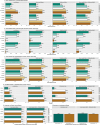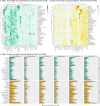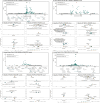This is a preprint.
Uncovering causal gene-tissue pairs and variants: A multivariable TWAS method controlling for infinitesimal effects
- PMID: 39711576
- PMCID: PMC11661321
- DOI: 10.21203/rs.3.rs-5285011/v1
Uncovering causal gene-tissue pairs and variants: A multivariable TWAS method controlling for infinitesimal effects
Update in
-
Uncovering causal gene-tissue pairs and variants through a multivariate TWAS controlling for infinitesimal effects.Nat Commun. 2025 Jul 2;16(1):6098. doi: 10.1038/s41467-025-61423-8. Nat Commun. 2025. PMID: 40603866 Free PMC article.
Abstract
Transcriptome-wide association studies (TWAS) are commonly used to prioritize causal genes underlying associations found in genome-wide association studies (GWAS) and have been extended to identify causal genes through multivariable TWAS methods. However, recent studies have shown that widespread infinitesimal effects due to polygenicity can impair the performance of these methods. In this report, we introduce a multivariable TWAS method named Tissue-Gene pairs, direct causal Variants, and Infinitesimal effects selector (TGVIS) to identify tissue-specific causal genes and direct causal variants while accounting for infinitesimal effects. In simulations, TGVIS maintains an accurate prioritization of causal gene-tissue pairs and variants and demonstrates comparable or superior power to existing approaches, regardless of the presence of infinitesimal effects. In the real data analysis of GWAS summary data of 45 cardiometabolic traits and expression/splicing quantitative trait loci (eQTL/sQTL) from 31 tissues, TGVIS improves causal gene prioritization and enhances the biological interpretability over existing methods.
Conflict of interest statement
Declarations of interests The authors declare no competing interests.
Figures






Similar articles
-
Uncovering causal gene-tissue pairs and variants: A multivariable TWAS method controlling for infinitesimal effects.medRxiv [Preprint]. 2024 Dec 10:2024.11.13.24317250. doi: 10.1101/2024.11.13.24317250. medRxiv. 2024. Update in: Nat Commun. 2025 Jul 2;16(1):6098. doi: 10.1038/s41467-025-61423-8. PMID: 39606410 Free PMC article. Updated. Preprint.
-
Uncovering causal gene-tissue pairs and variants through a multivariate TWAS controlling for infinitesimal effects.Nat Commun. 2025 Jul 2;16(1):6098. doi: 10.1038/s41467-025-61423-8. Nat Commun. 2025. PMID: 40603866 Free PMC article.
-
The Lived Experience of Autistic Adults in Employment: A Systematic Search and Synthesis.Autism Adulthood. 2024 Dec 2;6(4):495-509. doi: 10.1089/aut.2022.0114. eCollection 2024 Dec. Autism Adulthood. 2024. PMID: 40018061 Review.
-
Can a Liquid Biopsy Detect Circulating Tumor DNA With Low-passage Whole-genome Sequencing in Patients With a Sarcoma? A Pilot Evaluation.Clin Orthop Relat Res. 2025 Jan 1;483(1):39-48. doi: 10.1097/CORR.0000000000003161. Epub 2024 Jun 21. Clin Orthop Relat Res. 2025. PMID: 38905450
-
Assessing the comparative effects of interventions in COPD: a tutorial on network meta-analysis for clinicians.Respir Res. 2024 Dec 21;25(1):438. doi: 10.1186/s12931-024-03056-x. Respir Res. 2024. PMID: 39709425 Free PMC article. Review.
References
-
- Mostafavi H., Spence J. P., Naqvi S. & Pritchard J. K. Systematic differences in discovery of genetic effects on gene expression and complex traits. Nat. Genet. 55, 1866–1875 (2023). - PubMed
Publication types
Grants and funding
LinkOut - more resources
Full Text Sources

